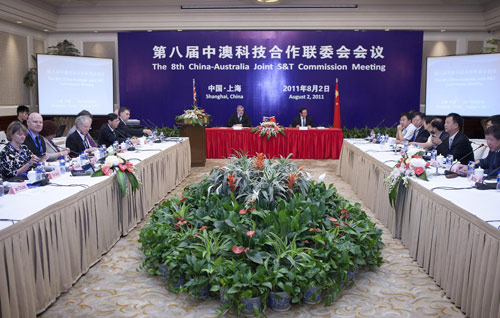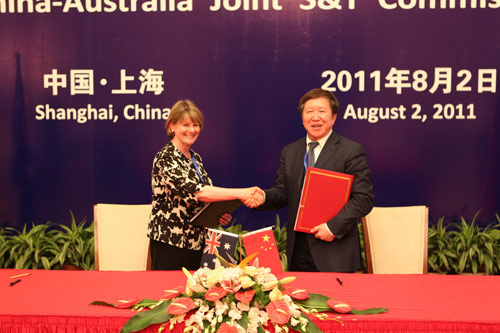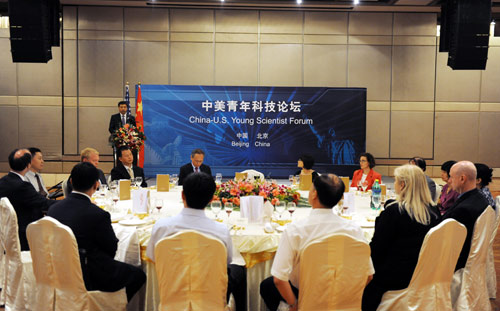CHINA SCIENCE AND TECHNOLOGY
NEWSLETTER
The Ministry of Science and Technology
People's Republic of China
|
|
|
N0.627 |
August 10, 2011 |
|
|
|
|
|
|
|
|
IN THIS ISSUE
|
|
* New Round China-Australia Joint Committee Meeting
*MOST and UNEP Water Resources Cooperation
*China-US Young Scientists Forum
* Four Mongolian Species Sequenced
* New Buoys Deployed in Western Pacific
* High Performance Metallic Glass
* Full Coverage Geographic Database
|
|
INTERNATIONAL COOPERATION |
New Round China-Australia Joint Committee Meeting



The 8th China-Australia Joint S&T Committee meeting was held on August 2, 2011 in Shanghai. WAN Gang, Chinese Minister of Science and Technology, and Kim CARR, Australian Minister for Innovation, Industry, Science and Research, spoke at the opening ceremony. WAN affirmed the importance of convening the Joint Commission meeting when China made public its science and technology planning for the 12th five-year period, and thought highly of the accomplishments derived from S&T cooperation between the two countries. He hopes the future S&T cooperation between the two countries will continue to contribute to changing the economic development mode, and to improving people's life.
After the opening ceremony, WAN and Carr jointly inked an MOU on science and research fund management. The two sides stated that the Fund is established to support the scientific and technological cooperation in the strategic fields, and to foster more long-term inter-agency partnerships. The Fund will be used to support the research projects in the priority areas, and establish joint research centers. The priority areas to be supported include agriculture and biological science, new energy, environmental protection, new materials, information and communication technology, mining, astronomy among others. The Fund will also be used to promote research alliances between industry, universities and research institutes, in a bid to spur up the commercial applications of S&T findings, and to enhance bilateral exchanges of S&T personnel.
The meeting was co-chaired by CAO Jianlin, Chinese Vice-Minister of Science and Technology, and Patricia KELLY, Australian Deputy Minister for Innovation, Industry, Science and Research. Both sides briefed the other side of the latest developments in innovation policy and based research, and shared the experience in promoting the commercial applications of R&D findings. Participants also reviewed the accomplishments derived from the cooperation financed by a special fund in the past decade, and proposed specific recommendations on strengthening the collaborations under the newly established Science and Research Fund, and reached broad consensus on future bilateral S&T cooperation.
MOST and UNEP Water Resources Cooperation

A meeting was held on August 3, 2011 in Beijing to discuss an African water resources project jointly initiated by the Chinese Ministry of Science and Technology (MOST) and the United Nations Environment Program (UNEP). The meeting is staged to discuss the details of collaboration, and define the framework for the cooperation accord. The cooperation project, jointly initiated by China, the United Nations, and African countries, works on water resources related technologies and studies, including water resources planning, water environment protection, water treatment, drought warning, water-saving agriculture, and sand control, in an attempt to enhance the technological capacity building of African countries, promoting the sustainable development across the continent.
CHEN Linhao, MOST Deputy Director of International Cooperation, submitted to the UNEP a draft document which reviewed the accomplishments and problems stemmed from phase-1 cooperation between MOST and UNEP, proposed the outlines for phase-II cooperation, and highlighted the rights and responsibilities to be shared by the two parties, hoping consensus be reached on the agreement to be signed by both parties for implementation. CHEN also briefed the UNEP side of the ongoing South-South cooperation in the area of climate change, hoping UNEP to be part of the efforts to prepare a technical manual for South-South cooperation in climate change (2nd edition), establish a platform for international cooperation in the area of climate change impacts adaptation and promoting the sustainable development, and prepare for a South-South cooperation seminar to be held in October to discuss the adaptation to climate change impacts using S&T means.
Project leaders discussed implementation details with UNEP representatives, and reached initial consensus on the individual countries and contents to be worked with. In the near future, the two sides will define the details and terms for the agreement to be officially signed for implementation in the second half of the year.
China-US Young Scientists Forum


The first China-US Young Scientists Forum was held on August 5, 2011 in Beijing. WANG Zhixue, Head of Science and Technology Daily, and Robert S Wang, charge d'affaires of the U.S. Embassy in Beijing, attended and spoke at the opening ceremony. Young scientists from 16 Chinese research institutes and 39 American universities attended the forum.
WANG Zhixue pointed out in his speech that China pursues an innovation policy that is open to the outside world, and it is willing to work with other countries and regions to address the common challenges facing the world. China will conduct S&T cooperation and exchange under the principle of equality and mutual benefit. Both China and the United States attach great importance to technology innovations, and both countries’ future will become more dependent on technology innovations that has to be addressed by young people. WANG added that the two governments will have their new round of S&T Joint Commission meeting be held on October in Beijing, which will further enhance the bilateral cooperation, deepen the friendship between the two peoples, and improve China-US relations.
The 2nd China-US Young Scientists Forum will be held in the Fall of 2011 in Washington DC. With the joint support of the Chinese Ministry of Science and Technology and the U.S. National Science Foundation, the American students who attended the forum have completed their two-month long research activities at Chinese research institutes.
Four Mongolian Species Sequenced
Inner Mongolia Agricultural University and Beijing Genomics Institute in Shenzhen announced on August 9, 2011 that they have sequenced the whole genome of Mongolian sheep, bovine, horse and Alashan camel. According to a briefing, the effort is part of the Inner Mongolian special species genome project, and part of BGI’s "thousand plants and animals genome program". Analysis results show that the Mongolian sheep has a genome size at 3Gb, Mongolia bovine 3.2Gb, Mongolian horse 2.8Gb, and Alashan camel 2.4Gb.
Scientists will compare the genomes, providing major scientific evidence to studying the origin, geographic distribution, and evolutionary ties of those animals. They will also explore and screen out new genes desirable for animals reproduction, raising animals’ productivity, laying a ground for raising the potentials of four Mongolian animals.
New Buoys Deployed in Western Pacific
"Science-1", a Chinese expedition boat, returned to the Qingdao port on August 4, 2011. The 31-day marine scientific expedition has completed a journey of 7,000 sea miles. Expedition members made a range of observations and experiments on hydrology, meteorology, chemistry, biology, geology, and marine equipment, in a northern Pacific area running from the east of Taiwan-the Philippines-Halmahera Island to the west of 135°E. Scientists completed survey missions at 56 sites in 8 sections.
The journey allowed the expedition boat to have recovered the two deep-sea buoys deployed in last expedition. One of them was positioned at a depth of 6,100m, the deepest buoy Chinese scientists have deployed in the western Pacific. Scientists dropped a new buoy to a depth of 6,000m in the original site, and two others to a depth of 3,000m in other sites.
Last November, Chinese scientists deployed a deep-sea buoy to a depth of 6,000m in the Western Pacific Ocean. It collected the velocity data of the Mindanao undercurrents through acoustic means for 16 days. A fast flow could hit the rate of 40cm/sec. The subsurface buoy recovered this time has carried 7-month old Mindanao undercurrents data, including flow rate and offshore salinity, temperature and depth, desirable for studying the Mindanao undercurrents and the long term variations of the upper part of Mindanao circulation. Understanding the long term variations of ocean circulations and heat flows will help people address global climate change, as ocean circulations and heat flows are the carriers of heat.
According to a briefing, the expedition also sea tried a Chinese made underwater glider, and collected valuable scientific data. The underwater glider, developed by CAS Shenyang Institute of Automation, made multiple dives to a depth of more than 4,000m in the Western Pacific. The glider worked smoothly under test indicators, and was successfully recovered after the experiment.
In addition, researchers successfully collected seabed soil for three consecutive times, using a seabed soil collector at a depth exceeding 3,000m in the western Pacific.
High Performance Metallic Glass
Thanks to many-year efforts, a research team, led by Prof. ZHANG Tao of Beijing University of Aeronautics and Astronautics, has landed major progresses in preparing metallic glass and associated mechanism studies, and rolled out the amorphous alloy materials desirable for making stretching mechanisms for satellite solar cell arrays. Researchers established an amorphous alloy lab for the purpose, through which they discovered a range of novel amorphous alloy systems, and improved their understanding of the mechanisms that forge metallic glass. In addition, they have worked out metallic glass containing light alloy, including aluminum, magnesium, and titanium, enjoying the merits of high strength, low melting point, and fine fluidity, desirable for preparing the parts and components in sophisticated shapes, like plastics.
Researchers developed the amorphous alloy materials desirable for making satellite solar array’s stretching mechanism. In the laboratory, solar array’s 20cm long titanium metallic glass spiral rod is able to reach the length of 2m when stretched out. Researchers also mixed metallic glass powder with lubricants to raise lubricating performance, taking advantage of high hardness, high flexibility, and low friction of metallic glass.
Geophysical Survey UAV
Not long ago, BGP researchers test flew an unmanned aerial remote sensing system in 6 flight routes at an altitude of 625m. It mapped an area of eight square kilometers in Zhuozhou, Hebei Province, and collected the image data of 10cm resolution.
WT-C02, the first UAV that cruised the Zhuozhou area, hit the altitude of 625m one minute after taking off. It aerial photographed the preset routes for 30 minutes.
The test fly is made to train ground control personnel, allowing them to master a range of techniques, including UAV assembly, remote control, route planning, and real-time monitoring. It is also a test fly prepared for petroleum prospecting and oil field emergency operations.
Digital Platform for Large Aircraft
At a forum held on July 28, 2011 to discuss space and aviation related information technology, people showed great interest in the development of Chinese made large aircraft C919. According to a briefing, a digital environment platform (IDEAL platform) has been established for C919 model, allowing C919 parts and materials suppliers, airworthiness authorities, designers, and users to work together under the same system for synergistic development, concurrent engineering, and off-site inspection.
C919 has, from the detail design stage, invited the involvement of international airworthy certification bodies. The IDEAL platform is established to facilitate the monitoring of project progress, in a bid to fence off the possible accidents caused by design defects.
Full Coverage Geographic Database
West mapping and 1:50000 basic geographic information database update, two major national surveying and mapping projects listed in China's 11th Five-Year Plan(2006-2010), have recently passed an acceptance check. The development means China has for the first time realized the full coverage of its land territories at a scale of 1:50000, making 2 million square kilometers of "no-map" areas in the west no longer blank.
According to SONG Chaozhi, deputy head of National Administration of Surveying, Mapping and Geoinformation, the West mapping project has employed a huge amount of satellite images, and the use of advanced mapping techniques has greatly reduced the field mapping workload. The completion of the West mapping project facilitates the completion of China’s fully covered land geographic information database at a scale of 1:50000.
The results of the two projects have found their applications in a range of national projects, including the first national water resources survey, the second national land resources survey, infrastructure capacity building for the west region, disaster prevention and mitigation, post-disaster reconstruction, ecological reconstruction and environmental protection of Three-River Origins among others. SONG said his Administration will further develop the database, making it part of the Map World, facilitating people’s daily traveling.
China’s Manned Space Station Names for Voting
Name soliciting campaign, initiated by China Manned Space Project Office to select logos and names for China's first manned space station, has entered the preliminary screening phase. 30 logos and names proposed by the public have been announced for public voting. The logos and names to be used at the manned space station fall under six categories, including the logo of China's manned space program, the name and logo of China's manned space station, the names of core modules, the names of experiment modules I and Ⅱ. The first 30 short-listed logos and names proposed by the public have been publicized for public voting. The review panel will cast its vote in September 1-5, 2011. The voting results will be weighed against the public voting results to finalize 10 logos and names.
Candidate logos and names were submitted by the public through internet, mobile phone, email, and mails to the review panel for preliminary screening.
Comments or inquiries on editorial matters or Newsletter content should be directed to:
Department of International Cooperation, MOST 15B, Fuxing Road, Beijing 100862, PR China Tel: (8610)58881360 Fax: (8610) 58881364
http://www.most.gov.cn

